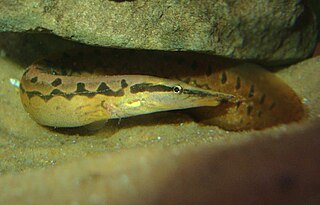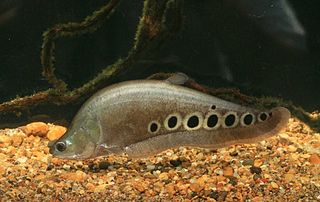
The Chao Phraya is the major river in Thailand, with its low alluvial plain forming the centre of the country. It flows through Bangkok and then into the Gulf of Thailand.

Synbranchiformes, often called swamp eels, though that name can also refer specifically to Synbranchidae, is an order of ray-finned fishes that are eel-like but have spiny rays, indicating that they belong to the superorder Acanthopterygii.

The snail kite is a bird of prey within the family Accipitridae, which also includes the eagles, hawks, and Old World vultures. Its relative, the slender-billed kite, is now again placed in Helicolestes, making the genus Rostrhamus monotypic. Usually, it is placed in the milvine kites, but the validity of that grouping is under investigation.

The walking catfish is a species of freshwater airbreathing catfish native to Southeast Asia. It is named for its ability to "walk" and wiggle across dry land, to find food or suitable environments. While it does not truly walk as most bipeds or quadrupeds do, it can use its pectoral fins to keep it upright as it makes a wiggling motion with snakelike movements to traverse land. This fish normally lives in slow-moving and often stagnant waters in ponds, swamps, streams, and rivers, as well as in flooded rice paddies, or temporary pools that may dry up. When this happens, its "walking" skill allows the fish to move to other aquatic environments. Considerable taxonomic confusion surrounds this species and it has frequently been confused with other close relatives. One main distinction between the walking catfish and the native North American ictalurid catfish with which it sometimes is confused, is that the walking catfish lacks an adipose fin. It can survive 18 hours out of water.

The red-tailed black shark, also known as the redtail shark and redtail sharkminnow, is a species of freshwater fish in the carp family, Cyprinidae. Despite its name, it is more closely related to carp. It is endemic to Thailand and currently critically endangered, but common in aquaria, where it is prized for its deep black body and vivid red or vivid orange tail. The red-tailed black sharks seen in the aquarium trade today are all captive bred.
The name spiny eel is used to describe members of two different families of fish: the freshwater Mastacembelidae of Asia and Africa, and the marine Notacanthidae. Both are so-named because of their eel-like shape and sturdy fin spines. These two families are not related: the Notacanthiformes belong to the Superorder Elopomorpha, whose members are characterized by having leptocephalus larvae. The freshwater Mastacembelids do not share this characteristic and are popular specimens in the aquarium trade.
Mastacembelus is a genus of many species of spiny eel fish from the family Mastacembelidae. They are native to Africa and Asia. Most are found in rivers and associated systems, but there are also species in other freshwater habitats and a particularly rich radiation is found in the Lake Tanganyika basin with 15 species. A few species can even occur in brackish water.

The Siamese algae-eater is a species of freshwater fish in the carp family, Cyprinidae. This bottom-dwelling tropical fish is found in mainland Southeast Asia, including the Chao Phraya and Mekong basins as well as the Malay Peninsula. Its natural habitats are streams and rivers as well as flooded forests during the rainy season. The Siamese algae-eater should not be confused with the flying fox or the false siamensis , lacking the distinctive black bands of the former.
Macrognathus is a genus of eel-like fish of the family Mastacembelidae of the order Synbranchiformes.

The zig-zag eel, also known as the tire-track, tire-track spiny- or marbled spiny eel, is a species of freshwater ray-finned fish in the family Mastacembelidae. It is native to the riverine systems of the Indian Subcontinent, Sri Lanka, Malaysia,Thailand, Vietnam, Cambodia, Indonesia, and other parts of South and Southeast Asia. The species was initially described as Macrognathus armature. Other common names for this popular captive species include the leopard spiny eel and white-spotted spiny eel.

The clown featherback, also known as the clown knifefish and spotted knifefish, is a nocturnal species of tropical fish with a long, knife-like body. This knifefish is native to freshwater habitats in Cambodia, China, Hong Kong, Laos, Macau, Taiwan, Thailand, and Vietnam, but it has also been introduced to regions outside its native range. It is one of the world's most invasive species.

The Asian swamp eel, also known as rice eel, ricefield eel, rice paddy eel or white rice-field eel, is a commercially important, air-breathing species of fish in the family Synbranchidae. It occurs in East and Southeast Asia, where it is a very common foodstuff sold throughout the region. It has been introduced to two areas near the Everglades in Florida and near Atlanta in Georgia.

Eels are ray-finned fish belonging to the order Anguilliformes, which consists of eight suborders, 20 families, 164 genera, and about 1000 species. Eels undergo considerable development from the early larval stage to the eventual adult stage and are usually predators.

The goldspotted eel, also known as the goldspotted snake eel or the dark-spotted snake eel, is an eel in the family Ophichthidae. It was described by Charles Alexandre Lesueur in 1825, originally under the genus Muraenophis. It is a marine, tropical eel which is known from the western and eastern Atlantic Ocean, including Bermuda, southern Florida, USA; the Bahamas, Santa Catarina, and Brazil. It dwells at a maximum depth of 15 metres (49 ft), and inhabits rocky and coral reefs. Males can reach a maximum total length of 110 centimetres (3.6 ft).

Elassoma evergladei, or the Everglades pygmy sunfish, is a species of fish from the genus Elassoma that is endemic to North America.
Macrognathus aral, the one-stripe spiny eel, is a small fish from Pakistan, India, Bangladesh, Nepal and Myanmar. It usually is found in running and stagnant waters of freshwater and brackish waters. It is 63.5 cm (25.0 in) in length.
Macrognathus zebrinus, the zebra spiny eel, is a species of spiny eel endemic to Myanmar, specifically known from the Irrawaddy River, Sittaung River and Salween River and may also occur in Indonesia. It was originally described as Mastacembelus zebrinus before being moved to the genus Macrognathus in 1984 and 1986.

Jakarta Aquarium and Safari is a marine and freshwater aquarium located within a retail and leisure complex Neo Soho in Jakarta, Indonesia. The aquarium is home to hundreds of mammal, reptile, insect and various types of Indonesian marine fish, is to introduce to the next generation the biodiversity of the archipelago starting from islands, forests, and mangroves.















